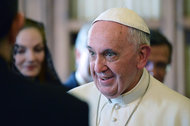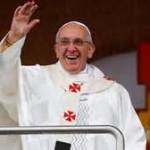Guest Blog
by Jone M. Bosworth, J.D.

Jone M. Bosworth, J.D.
Visiting a dear friend in Omaha recently, she shared something one of her Catholic priests mentioned to her: “He said that he was walking out of a restaurant one night, wearing his collar, and an apparently homeless woman stopped him and said, hey, I like your Pope.”
Once I got past the sense that this embodies the makings of a good joke, and consternated about whether the priest had done something immediately to assist the woman (he didn’t, at least according to the second-hand story), I realized that I was in radical agreement with the homeless woman: I like Pope Francis’ leadership thus far too.
I’m not Catholic but I do recognize that popes are incredibly important global CEOs. Because how they lead matters to so many, it also matters to me. According to the Vatican, there are 1.2 Billion Catholics in the world today. In the U.S., 72.8 people self-identify as Catholics.
When His Holiness Pope Francis presented the vision for his papacy, he showed who he is as a leader. He called on Catholics to battle the “globalization of indifference” and challenged the church to be more compassionate, to champion the poor and work to achieve social justice.
Five Francis-Catalyzed Leadership Reflections
- As CEOs, the sheer volume of followers makes leading as Pope tricky. It is pretty hard to make 1.2 Billion people comfortable that you’re leading them how they want to be led.
Leadership, however, isn’t really about popularity but about influence, integrity — using your ‘whole person,’ your skills, knowledge, your gut and heart instincts—to do the right thing. Impressively, Pope Francis sent out a survey to gain followers’ perspectives—that’s leading.
- Popes, like most leaders, have to deal with followers who make their own decisions about whether to follow or not. For popes, there’s been a significant shift in followers over the past few decades. The BBC paints the picture of this through data, “{s]ince 1970, Catholicism has seen a global shift southwards – the proportion of Catholics living in Europe has declined, while Africa has seen a growth in the number of Catholics – from 45 million in 1970 to 176 million in 2012. Asia has also seen a growth in Catholicism and now represents almost 12% of the total Catholic population in the world, or 137 million people.” BBC News
For all leaders today, recognition of massive social, economic, technological and climate shifts should be impacting what you do, but it does not mean changing your values. Pope Francis is clearly mindful that the world has changed and continues to change at a rapid rate. Still, he is making his vision and values courageously clear—that’s leading.
- Popes experience “loose/tight” control despite the centralized veneer of the (“home office”) Vatican. There’s no way Pope-as-CEO can actually control what churches, and what individual Catholics, do. I’d wager that he cannot even control his managers at the Vatican if history holds true. I suppose popes do have a carrot, something like ‘get into heaven’ or for the extraordinary few, become a saint, but there’s not much of a stick here on earth. (If my ignorance of Catholic practice shows, apologies to all Catholics but this is generally how it goes, right?)
Likewise for all secular leaders, carrot/sticks aren’t really all that meaningful, it is inspiration that influences followers, its letting followers know that you really value them, care about their well-being that matters, not threats of penalties. Pope Francis picks up the phone and calls followers directly in response to letters they’ve written to him—that’s leading.
- Popes have unique communication challenges due to a culturally diverse and diffuse population of followers. Not only has Pope Francis committed his leadership vision and expectations to written form, his actions speak volumes. This CEO takes the bus. This CEO washes people’s feet. This CEO has a twitter account.
As leaders, demonstrating who you are with actions will go a long way toward bridging communication gaps across cultures and individuals. Pope Francis’ actions actually spoke to the world before his “Evangelii Gaudium” document did—that’s leading.
- Francis is up against what most leaders face: resistance to change. One of the most compelling things Pope Francis has said is that doing things the same old way is not at all what he expects; he expects boldness, he expects kindness, and he desires greater connectedness and, gulp, he expects people to change.
There’s nothing more courageous than taking on the status quo. Woodrow Wilson famously wrote, “If you want to make enemies, try to change something.” For a global CEO to not only talk about change but to live, breathe and act upon a clear vision for change over time shows extraordinary leadership. So far, Francis has shown himself to be a model for change in words and deeds, but of course, overcoming the resistance to change will be the true test—that’s leading.
To quote a wise woman, hey, I like your Pope.


Photo Credit: Vincenzo Pinto/Agence France-Presse — Getty Images)
Jone M. Bosworth, J.D. is the CEO of inCourage Leading, LLC. She writes about leadership, advancing women, and loves serving as strategist and executive coach for leaders and business that care beyond the bottom line by being mindful about the entire human family’s success. Follow Jone at http://incourageleading.com and @jonebosworth. She loves connecting via jone@incourageleading.com
